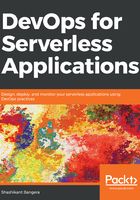
Canary deployment
Canary deployment is a deployment technique involving a gradual shift in production traffic from version A to version B, where version B is the latest version and version A is the previous version. AWS has recently introduced traffic shifting for Lambda functions aliases. An alias is a pointer to a specific version of the Lambda functions, which basically means that we can split the traffic of the functions between two different versions by specifying the percentage of incoming traffic that we want to direct to the new release. Lambda will automatically load balance requests between versions when aliases are invoked. So instead of replacing one function with another version, both versions can coexist and can be monitored as to how they perform.
All of this sounds awesome, but doing all this it not that easy. Fortunately, AWS already has a service that will help us with this problem—CodeDeploy. To use canary deployment with the AWS CodeDeploy service, we need to create a variety of resources. We need to create a CodeDeploy application, a deployment group, and aliases for the functions. We also need to create new permissions and replace all the event sources to trigger the aliases instead of the latest functions. But this can be much easier if we use the canary deployment plugin with Serverless Framework. Let's learn how we can achieve this using an example.